Creating an MVE Integrated with Versa
This topic describes how to create and configure a Megaport Virtual Edge (MVE) with Versa Secure SD-WAN. Before you begin, you need user accounts with ordering permissions that provide access to the Megaport Portal and to Versa.
For more information on setting up a Megaport account, see Creating an Account.
Tip
Versa provides documentation for their SD-WAN product, including Versa Director and cloud connections, at VOS SD-WAN Configuration Product Documentation. (Access requires registration.)
Basic steps
The basic steps to configure an MVE with Versa are:
- Obtain information for Versa Director.
- Create a new workflow template in Director.
- Add a new device group in Director.
- Add a new device in Director.
- Create the Versa MVE Instance in the Megaport Portal.
- View the MVE public IP address assignment in the Megaport Portal.
- Verify that the MVE is registered and is in-sync from the Versa Director UI.
The following sections provide detailed instructions.
Obtaining required information for Versa Director
To set up Versa you need the following information:
- Versa Director IPv4 address or FQDN – For example: cloud211.versa-networks.com.
-
Versa Controller IPv4 address or FQDN – In Versa Director, select the Configuration tab in the top menu bar. Select Templates > Device Templates in the horizontal menu bar, and select a template. In the template details page, select the Services tab (the gear icon) and then select SDWAN > System > Controller Config. The window displays a list of controllers, their IP address, and any assigned FQDNs.

-
Local Auth String – The default is SDWAN-Branch@Versa.com which can be modified in Versa Director.
- Remote Auth String – The default is Controller-1-staging@Versa.com which can be modified in Versa Director.
- Serial Number – This value is created when you add a new device in Versa Director.
Creating a new workflow template in Director
The next step is to create a new workflow template and device in Versa Director. Versa strongly suggests using their workflows for creating templates and devices. The workflows automatically build and create some behind-the-scenes configurations and variable values that could otherwise be missed.
To create a new workflow template in Director
-
Log in to Versa Director.
-
Select the Workflows tab in the top menu bar.
-
In the left navigation, select Template > Templates.
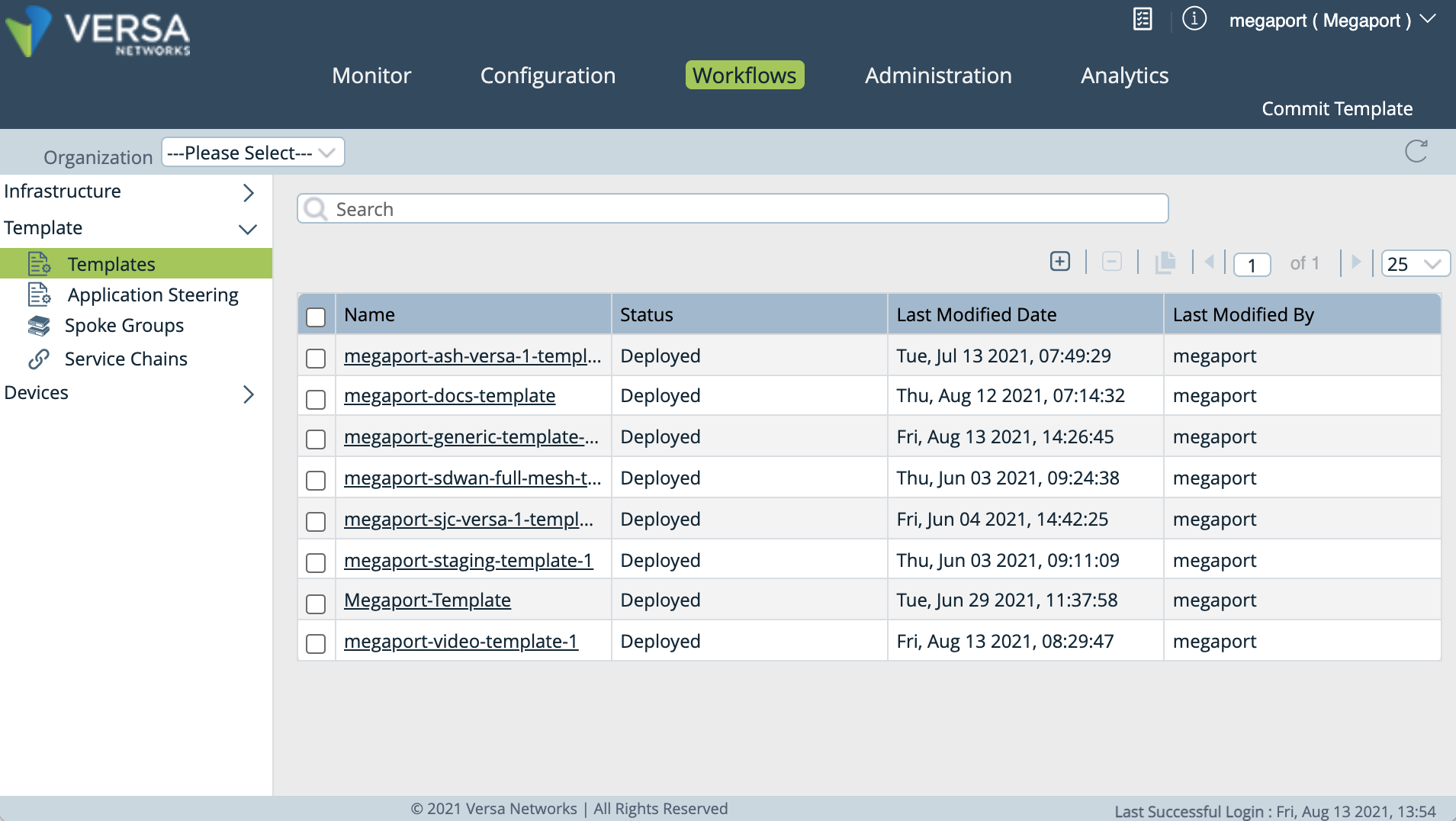
-
Click
 (Add) to create a template.
(Add) to create a template. -
In the Basic tab, specify these details.
- Name – Enter a name for the staging template.
- Type – Select the template type SDWAN Post Staging from the drop-down menu.
- Organization – Select the provider organization to associate with the template.
- Device Type – Select SDWAN from the drop-down menu.
- Select the appropriate role (Full Mesh, Hub, Hub Controller, or Spoke).
- Controllers – Select a controller node from your network to associate with the template.
- Subscription – Select the appropriate subscription information for your network.
- Solution Tier – Network service to be configured.
- Service Bandwidth – Allocated bandwidth for the service in Mbps.
-
Preferred Software Version – Preferred version of the software that should be deployed on Versa Director. The preferred software version applies to zero-touch provisioning (ZTP). During ZTP, Versa Director upgrades a branch to the preferred version, if applicable. The preferred version can be backward compatible for up to two previous VOS versions.

For more information about creating Versa staging templates, see Create and Manage Staging and Post-Staging Templates.
-
Select the Interfaces tab and specify these details.
- Number of Ports – Choose 4. MVE requires 4 ports.
Note, Port 0 is reserved for management (Mgmt) and cannot be changed. - Click the icon for port 1 and select WAN from the drop-down menu. A row is added to the WAN Interfaces list. (The WAN interface is automatically configured by the MVE creation process to connect through the Megaport Internet connection with bandwidth determined by the MVE size.)
- VLAN ID – The value should be set to 0.
- Network Name – The value should be set to INET-1.
- IPv4 – The value should be set to DHCP.
- The remaining fields can be left unchanged.
Note
You can optionally enter circuit information.
- Number of Ports – Choose 4. MVE requires 4 ports.
-
Click Continue (at the bottom right) until you see the Create option, then click Create.
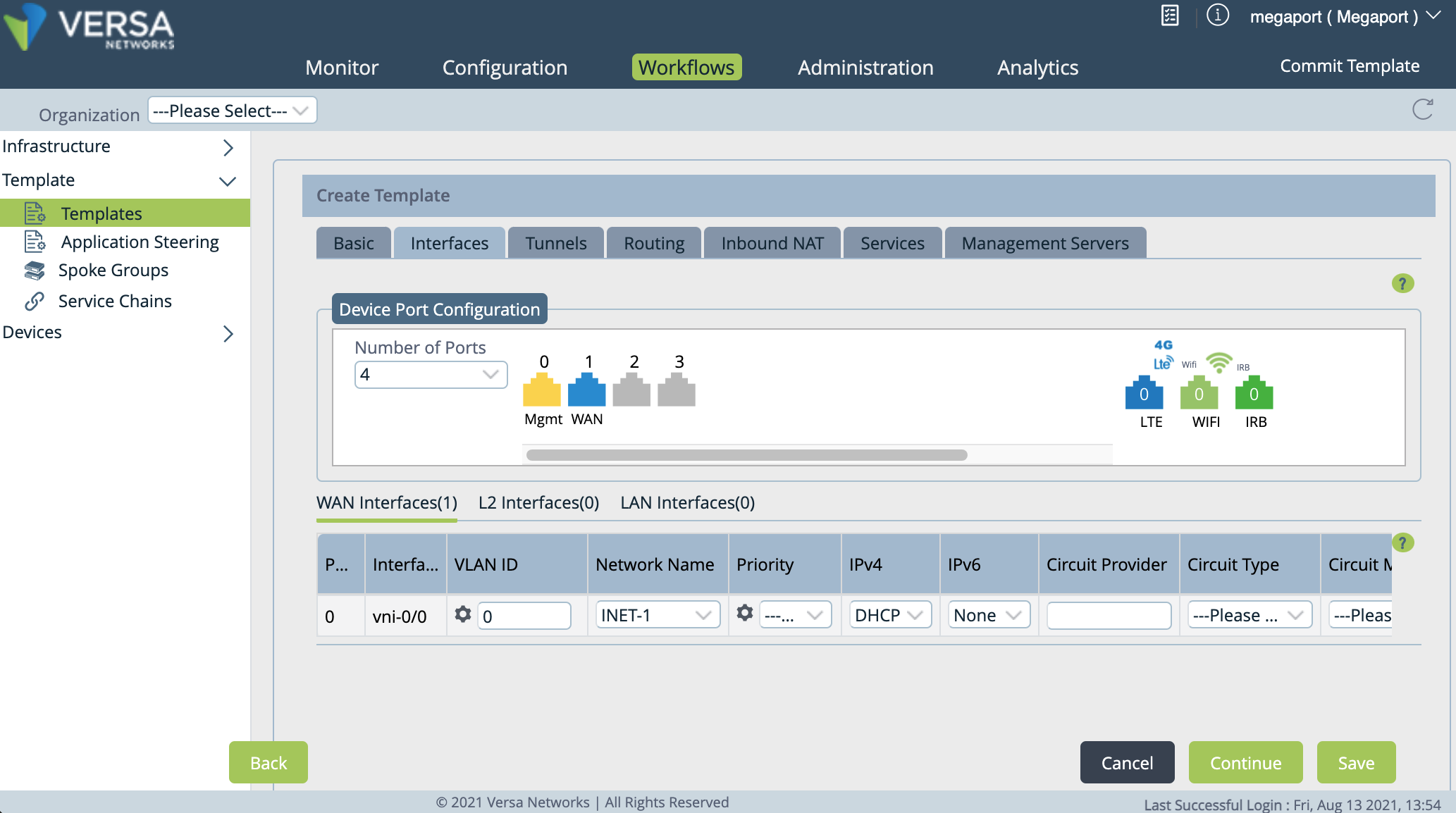
You can now apply the template to a new device group.
Adding a new device group in Director
The next step is to create a new device group.
-
Log in to Versa Director.
-
Select the Configuration tab in the top menu bar.
-
In the horizontal menu bar, select Devices > Device Groups.

-
Click
 (Add) to add a device group.
(Add) to add a device group. -
Specify these details:
- Name – Enter a name for the device group that is easily identifiable.
- Description – Enter descriptive information about the device group.
- Tags (optional) – Enter strings for users to search on.
- Organization – Select your organization from the drop-down.
- Post Staging Template – Select the template you created previously.

-
Click OK.
Adding a new device in Director
The next step is to add a new device.
-
Log in to Versa Director.
-
Select the Workflows tab in the top menu bar.
-
In the left navigation, select Devices > Devices.
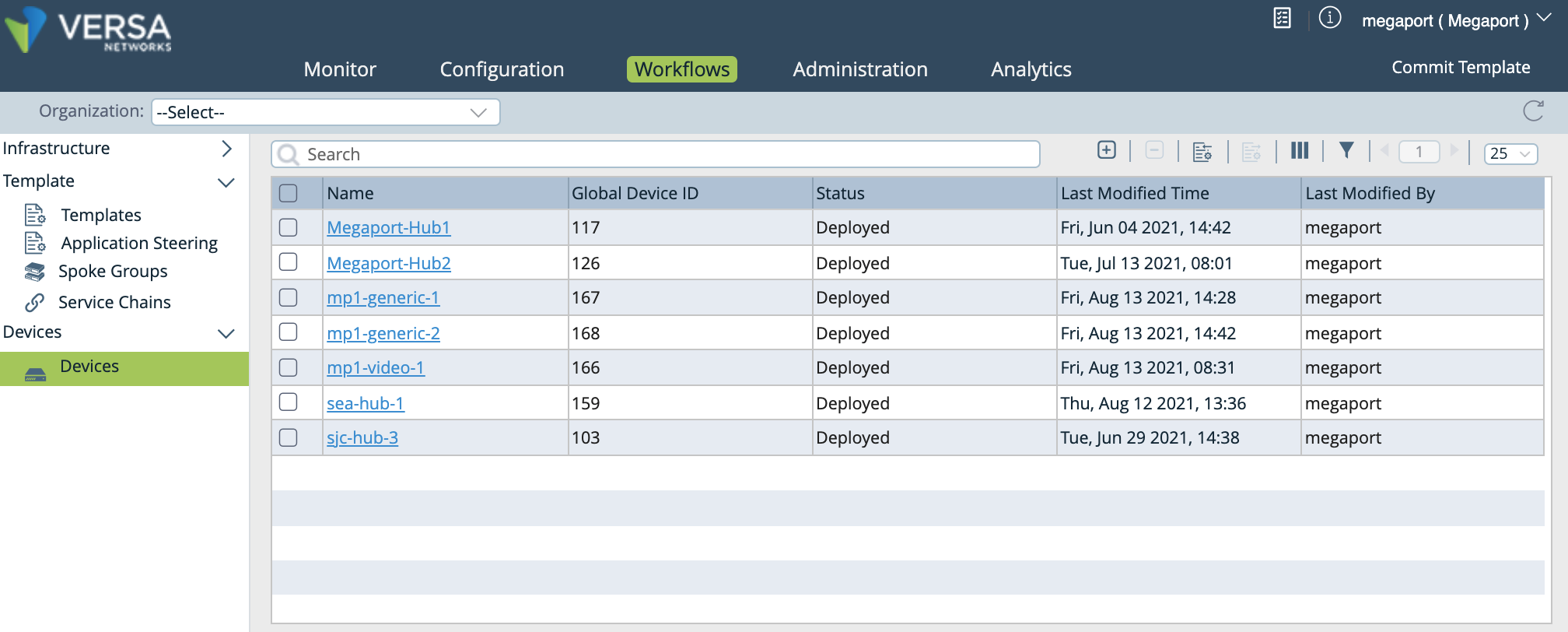
-
Click
 (Add) to open the Add Device window.
(Add) to open the Add Device window.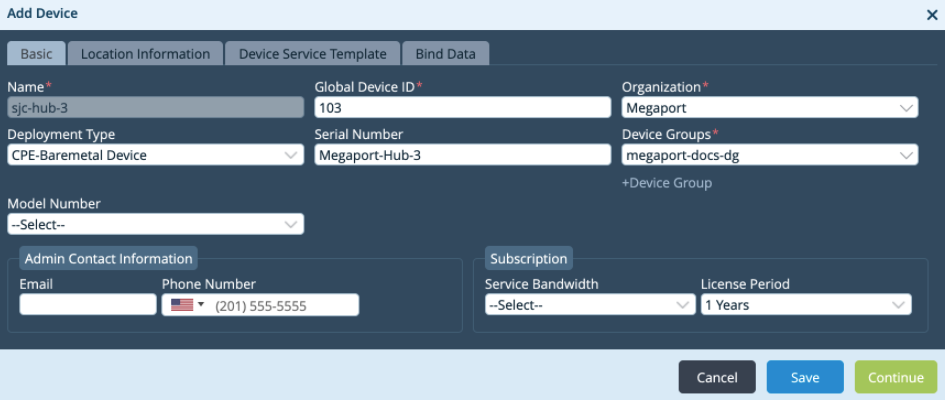
-
In the Basic tab, specify these details.
- Name – Specify a meaningful name for the device.
- Global Device ID – Versa Director automatically assigns the next available ID.
- Organization – Choose your organization from the drop-down.
- Deployment Type – Choose CPE-Baremetal Device from the drop-down.
- Serial Number – Enter a serial number for the device. Specify a unique and meaningful value for the device and make a note of it, as you need it again when creating the Versa MVE instance in the Megaport Portal.
- Device Groups – Choose the device group you created previously. This will assign the new device to that device group.
-
Click Continue.
-
In the Location Information tab, enter the country where the device is located.
-
Click Continue until you see the Deploy button.
-
Click Deploy.
The new device is now deployed in Versa Director.
Creating an MVE in the Megaport Portal
Before you create an MVE, you need to determine the best location - one that supports MVE and one that is in the most compatible metro area. You can connect multiple locations to an individual MVE. For more information about location details, see Planning Your Deployment.
You can deploy multiple MVEs within the same metropolitan area for redundancy or capacity reasons. As part of the MVE creation process, you will also create a Megaport Internet connection.
To create an MVE
- In the Megaport Portal, go to the Services page.
-
Click Create MVE.

-
Select the MVE location.
Select a location geographically close to your target branch and/or on-premises locations.
The country you choose must be a market in which you have already registered.
If you haven’t registered a billing market in the location where you will deploy the MVE, follow the procedure in Enabling Billing Markets.
To search for your local market in the list, enter a country in the Country Filter or a metro region detail in the Search filter.
-
Select a diversity zone.
You can select either Red or Blue, or select Auto and have Megaport select the zone for you. The selected or allocated diversity zone will be displayed on the location details through the rest of the provisioning, and on the summary page at the end.
For more information, see MCR and MVE Diversity.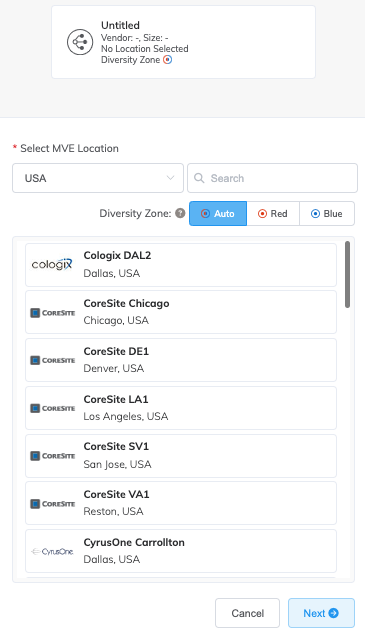
-
Click Next.
-
Select Versa FlexVNF.
-
Specify the MVE details:
-
Version – Select the software version. The MVE will be configured to be compatible with that version of Versa.
-
MVE Name – Enter a name for the MVE that is easily identifiable, particularly if you plan on provisioning more than one. This name appears in the Megaport Portal.
-
Size – Select a size from the drop-down list. The list displays all sizes that match the CPU capacity at the selected location. The sizes support varying numbers of concurrent connections, and individual partner product metrics vary slightly. For more information, see Planning Your Deployment.
Note
If the MVE size you want is not in the list, then there is not enough capacity at the selected location. You can either select another location with enough capacity or contact your Account Manager to discuss requirements.
-
Service Level Reference (optional) – Specify a unique identifying number for the MVE to be used for billing purposes, such as a cost center number or a unique customer ID. The service level reference number appears for each service under the Product section of the invoice. You can also edit this field for an existing service.
-
Director Address – Enter the FQDN or IPv4 address of your Versa Director.
-
Controller Address – Enter the FQDN or IPv4 address of your Versa Controller.
-
Local Auth – Enter the Local Auth string as configured in your Versa Director.
-
Remote Auth – Enter the Remote Auth string as configured in your Versa Director.
-
Serial Number – Enter the serial number that you used when creating the device in Versa Director.
-
Virtual Interfaces (vNICs) – Each MVE is configured with one vNICs named Data Plane by default. To change the name, type over the name text in the box.
You can add a total of five vNICs to the MVE, including the one added by default. For more information, see Types of vNIC Connections.
To add a vNIC:
-
Click + Add.

-
Enter a name for the vNIC.

Note
If you want to increase or decrease the number of vNICs on this MVE after it has been deployed, you will have to delete the entire MVE and recreate it. You can’t add or delete vNICs on a deployed MVE.
-
-
Minimum Term – Select No Minimum Term, 12 Months, 24 Months, or 36 Months. Longer terms result in a lower monthly rate. 12 Months is selected by default. For more information, see MVE Pricing and Contract Terms.
Note
Partner and partner-managed accounts select MVE subscriptions instead of MVE contract terms.
-
-
Click Next to view the Summary page.
The monthly rate is based on location and size. -
Confirm the configuration and pricing then click Add MVE.
You are prompted to create a Megaport Internet connection. A Megaport Internet connection provides connectivity and allows MVE to register and communicate with Versa SD-WAN.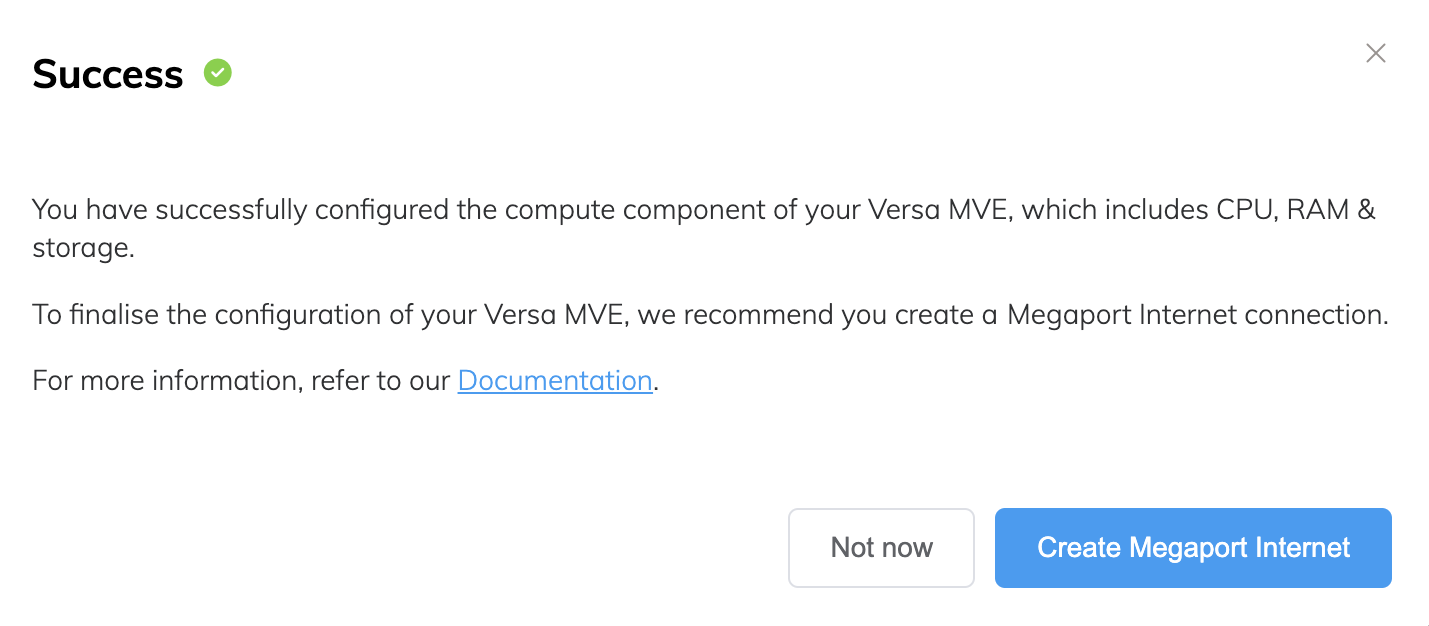
To create the Megaport Internet connection
-
Click Create Megaport Internet to proceed (recommended), or click Not now to provision internet access at a later time.
Note
MVE requires connectivity to the internet onto the management plane virtual interface. You can either provision a Megaport Internet connection or configure a third-party internet connection using a private VXC. We strongly recommend that you create a Megaport Internet connection for the initial MVE startup and deployment to ensure that the MVE is provisioned and functioning correctly.
-
Select the target Port (the internet router).
The B-End of a Megaport Internet connection can be anywhere that Megaport Internet is available.
You can filter by diversity zone, or select to view all. -
Click Next.
-
Specify the connection details:
-
Connection Name – The name of your Megaport Internet connection to be shown in the Megaport Portal.
-
Service Level Reference (optional) – Specify a unique identifying number for the Megaport Internet connection to be used for billing purposes, such as a cost center number or a unique customer ID. The service level reference number appears for each service under the Product section of the invoice.
Tip
Use the same Service Level Reference numbers for the Megaport Internet connection and MVE to help identify the matching pair in your invoice.
-
Rate Limit – The speed of your connection in Mbps. The speed is adjustable from 20 Mbps to 10 Gbps in increments of 1 Mbps. You can change the speed as needed after you create the Megaport Internet connection. Monthly billing details appear based on location and rate limit.
-
VXC State – Select Enabled or Shut Down to define the initial state of the connection. For more information, see Shutting Down a VXC for Failover Testing.
Note
If you select Shut Down, traffic will not flow through this service and it will behave as if it was down on the Megaport network. Billing for this service will remain active and you will still be charged for this connection.
-
A-End vNIC - Specify a vNIC from the drop-down list. The list shows the vNICs that were created with the MVE.
-
Preferred A-End VLAN (optional) – Specify an unused VLAN ID for this connection. This must be a unique VLAN ID on this MVE and can range from 2 to 4093. If you specify a VLAN ID that is already in use, the system displays the next available VLAN number. The VLAN ID must be unique to proceed with the order. If you don’t specify a value, Megaport will assign one.
Alternatively, you can click Untag. This selection removes the VLAN tagging for this connection and it will be configured without a VLAN ID. -
Minimum Term – Select No Minimum Term, 12 Months, 24 Months, or 36 Months. Longer terms result in a lower monthly rate. 12 Months is selected by default.
Take note of the information on the screen to avoid early termination fees (ETF). For more information, see Megaport Internet Pricing and Contract Terms and VXC, Megaport Internet, and IX Billing.
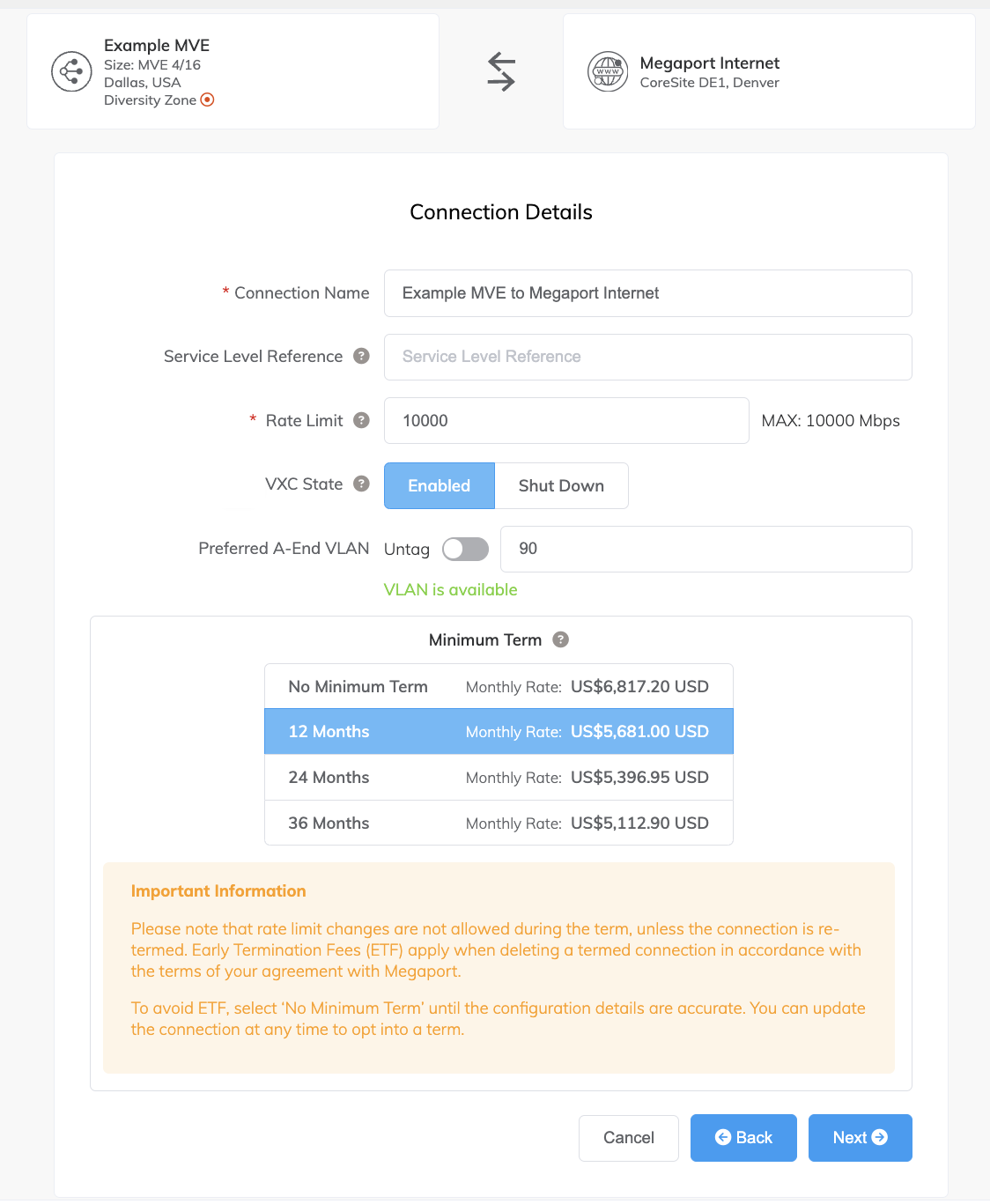
-
-
Click Next to proceed to the connection detail summary.
-
Click Add VXC to order the connection.
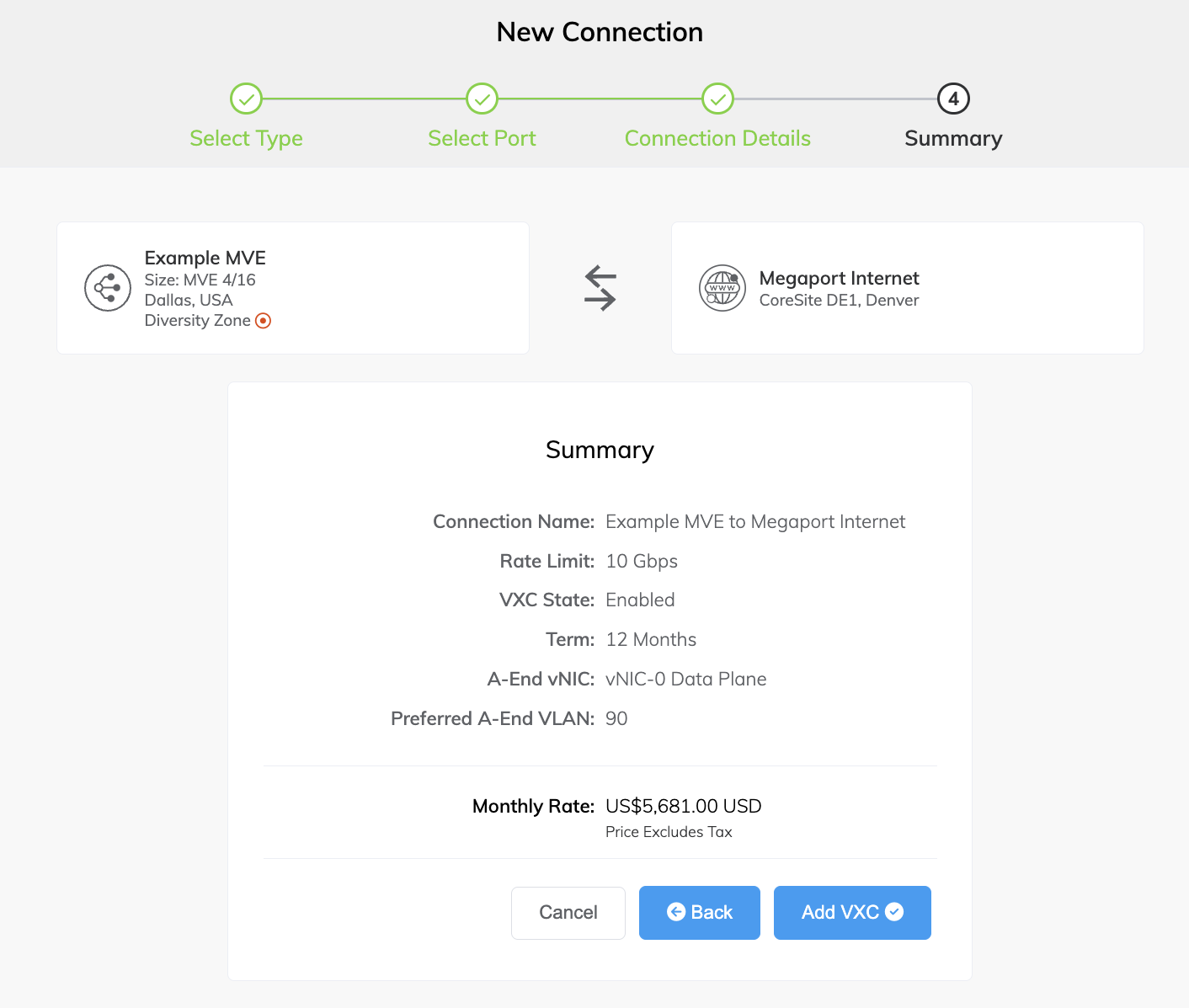
-
Click Order.
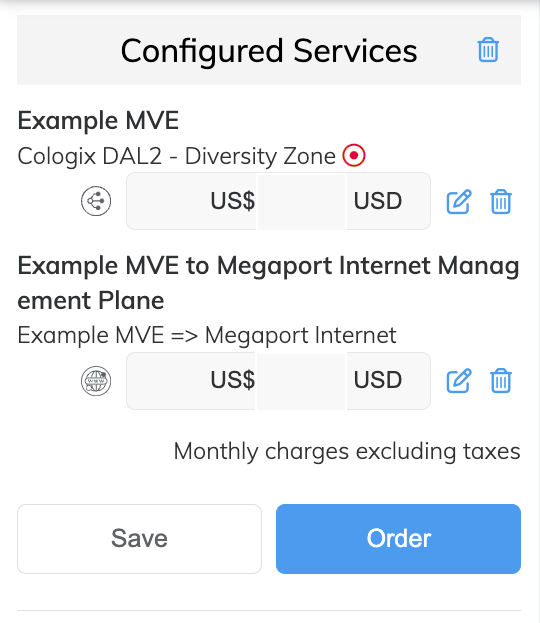
-
If you have a promotional code, click Add Promo Code, enter it, then click Add Code.
-
Click Order Now.
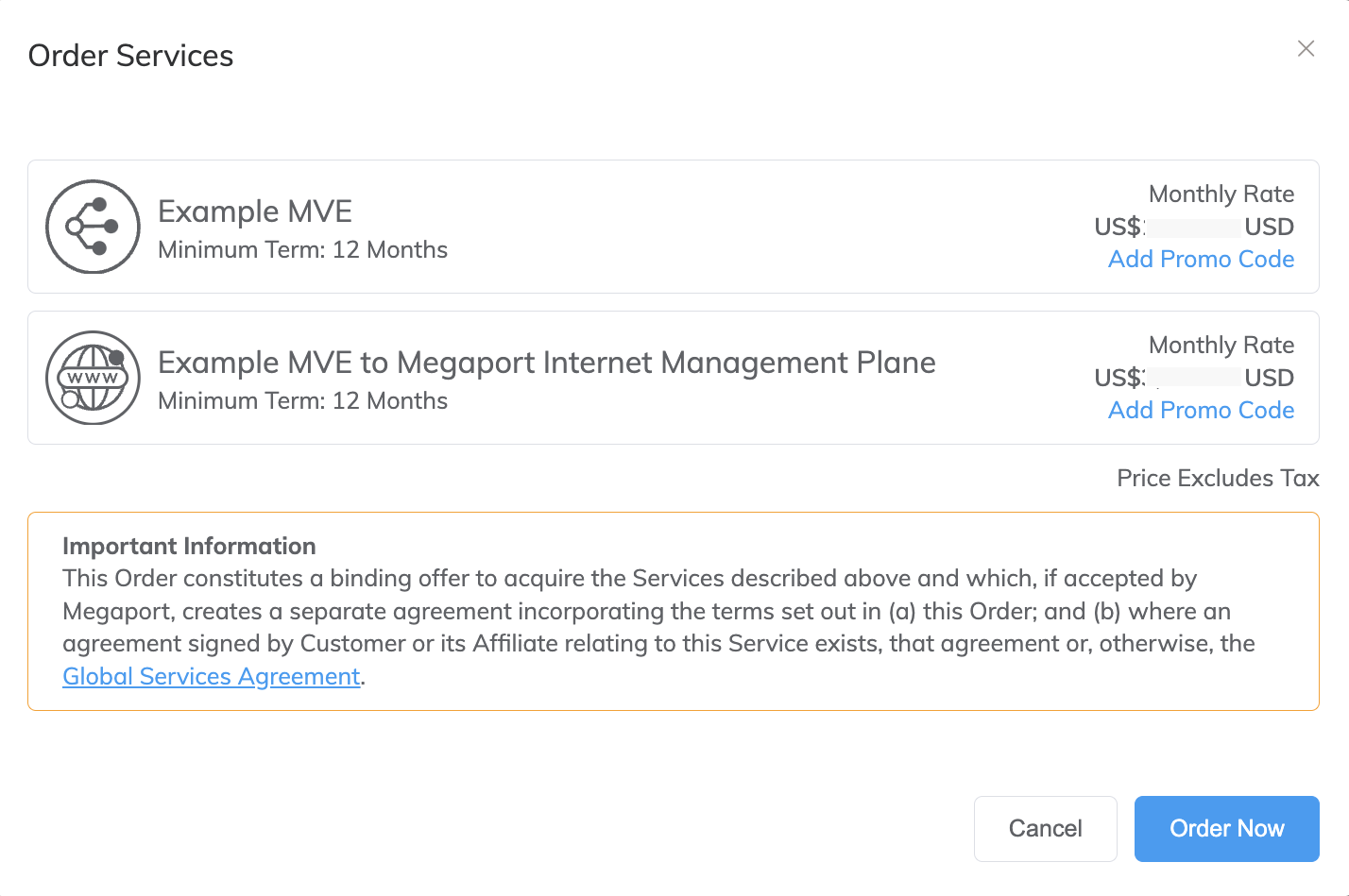
Ordering MVE provisions the appliance and assigns IP addresses from the Megaport SDN. The MVE provisioning takes only a few minutes to complete. The provisioning process spins up a Versa FlexVNF.
Viewing the MVE in the Megaport Portal
After creating the MVE, you can view it in the Megaport Portal on the Services page. You can also view the public IP addresses assigned.
To view an MVE in the Megaport Portal
- Go to the Services page.

The Megaport Internet icon differs from a standard VXC icon in the Megaport Portal, as shown in the image.
For more information on the Services page, see Understanding the Services Page.
To view the public IP addresses assigned to the MVE
-
Click the gear icon
 next to the Megaport Internet connection.
next to the Megaport Internet connection.
The Connection Configuration screen appears. From here, you can modify any of the Megaport Internet connection details. -
Select the Details tab.
-
Locate the public IP address (IPv4 or IPv6).
These are the public IP addresses assigned to the MVE. Make a note of these addresses for use later. -
Verify that you see your new MVE device in the Megaport Portal under Services.
Viewing the MVE in Versa Director
After creating the MVE, you can monitor the status in Director. In Director, verify that the new MVE configuration is synchronized, the service is up, and it is reachable.
To view an MVE in Director
-
Log in to Versa Director.
-
Select the Monitor tab, then select Devices in the horizontal menu.
-
Review the Config Synchronized, Reachability and Service columns.

Note
It can take up to 10 minutes for the MVE to register with Versa Director.
Next steps
Once the MVE is provisioned with an Active status, the next step is to connect a VXC to a CSP, a local port, or a third-party network. You can optionally connect a physical Port to the MVE through a private VXC or connect to a service provider in the Megaport Marketplace.
For more information, see Creating a VXC.